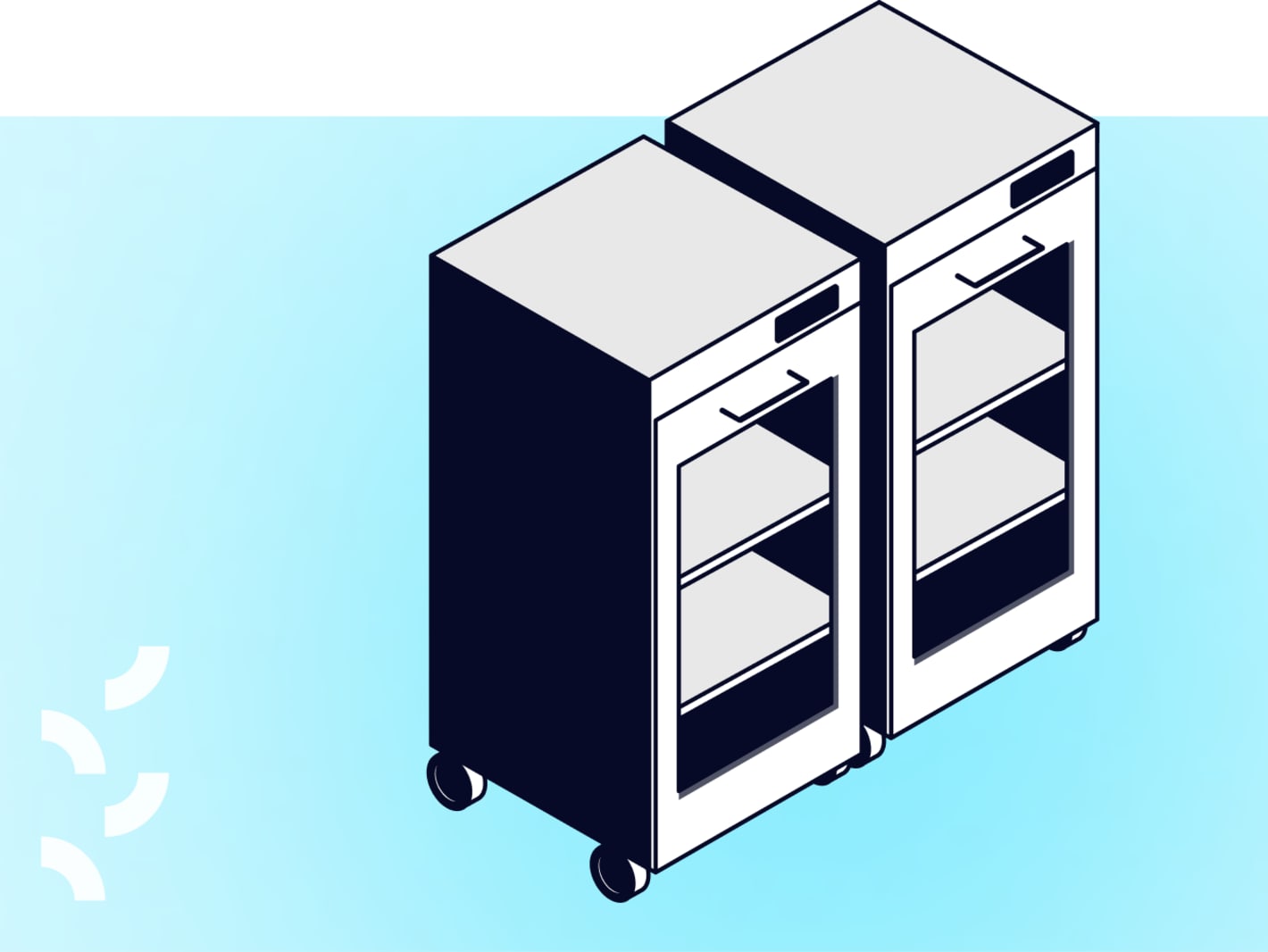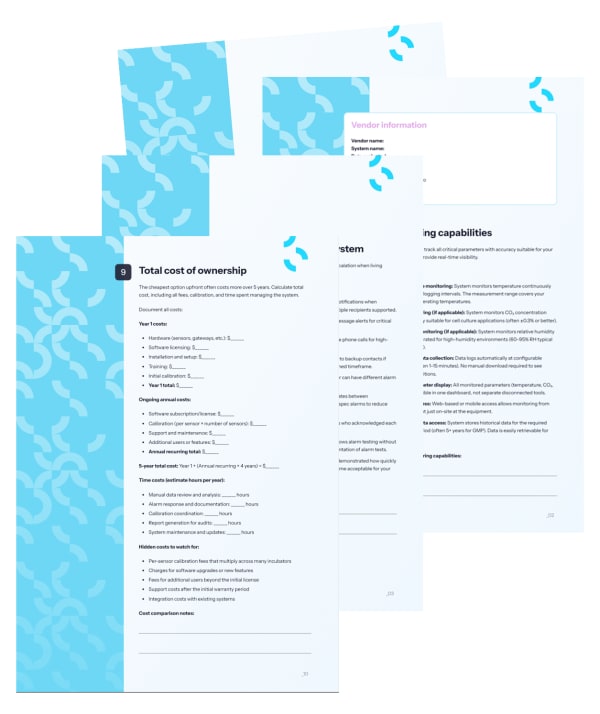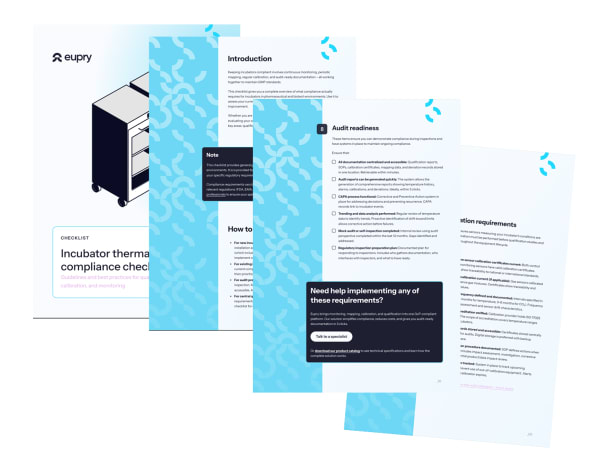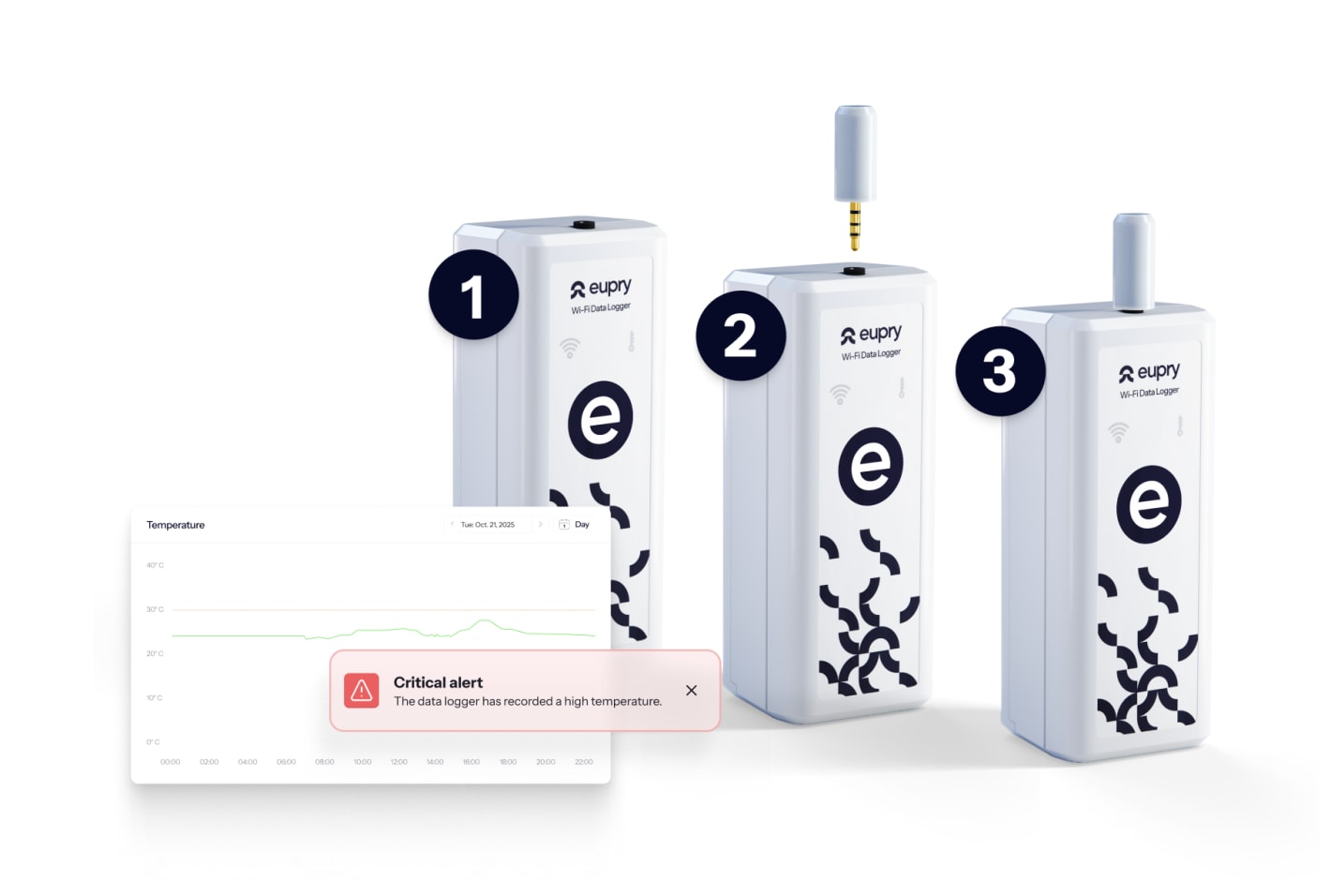How to choose an incubator monitoring system
Buyer's guide for pharma, biotech, and microbiology labs

Adam Hartmann-Kruckow
How to choose incubator monitoring systems for pharma and biotech labs – which features and capabilities to look for, requirements to live up to, vendor questions to ask, and issues to sidestep.
Step-by-step checklist to systematically evaluate monitoring systems.

Incubators hold some of your most critical work – cell cultures, microbiology samples, stability studies, and vaccine production. A temperature excursion you don't catch in time means lost batches, failed experiments, or compromised test results that delay everything downstream.
Choosing an incubator monitoring system is not just about tracking temperature. You need CO₂ accuracy, humidity control, alarm reliability, data integrity, calibration that doesn't create downtime, and compliance with USP <1117> and GxP requirements. The wrong system creates more problems than it solves.
This guide walks through what actually matters when evaluating incubator monitoring solutions – the features that prevent problems, the mistakes that cost you, and the questions to ask vendors before you commit.
Ready to evaluate monitoring systems? Download our incubator monitoring comparison checklist or book a talk to see how Eupry handles the specific challenges of incubator compliance.
What makes incubator monitoring different from general temperature monitoring?
Incubators maintain precise environmental conditions for living samples – conditions where small deviations have immediate consequences.
Here are some of the things that make incubator monitoring unique:
CO₂ control is critical for cell culture work. Many incubators maintain 5–6% CO₂ to support mammalian cell growth. CO₂ sensors drift faster than temperature sensors (often requiring calibration every 3–6 months), and CO₂ deviations affect pH, which impacts cell viability. Your monitoring system needs to track CO₂ with the same rigor as temperature.
Humidity impacts sample integrity. Microbiology plates dry out if the humidity drops too low. Cell cultures experience osmotic stress. Your monitoring system should track relative humidity in incubators where this parameter matters, and sensors need to handle high-humidity environments without frequent failure.
Samples cannot wait. Unlike warehouses, where products might tolerate brief excursions, living samples in incubators die quickly when conditions fail. You need real-time alerts, not data you review hours later.
USP <1117> sets equipment control expectations. Labs conducting microbiology work under USP <1117> must demonstrate equipment control, documented monitoring, and alarm validation. Generic monitoring solutions often don't address these specific requirements.
Multiple incubators create visibility challenges. Pharma and biotech facilities run dozens or hundreds of incubators across multiple sites. You need centralized visibility, not individual systems that require site visits to check status.
Qualification and ongoing compliance requirements. Incubators require IQ/OQ/PQ qualification, periodic requalification, and continuous evidence of performance. Your monitoring system needs to support these validation activities without creating extra work.
Also read: How to handle thermal compliance for incubators: Guidelines for validation, mapping, and monitoring
What features should you evaluate when choosing an incubator monitoring system?
When you are comparing monitoring systems for incubators, focus on features that directly impact your ability to maintain compliance and catch problems before they cause damage.
This is features such as real-time monitoring, instant alerts, CO₂ and humidity sensors, calibration approach, visibility, 21 CFR Part 11 compliance, support for qualification, and total cost of ownership.
Learn more about what to look for in the following sections:
Does the system provide real-time monitoring and immediate alerts?
Why it matters: Delayed detection means lost samples. If your monitoring system only logs data for later review, you won't know about a problem until it's too late.
What to look for:
- Continuous data collection at defined intervals (typically 1–15 minutes)
- Automated alerts via email, SMS, or phone when temperature, CO₂, or humidity exceed thresholds
- Alarm escalation if initial alerts aren't acknowledged
- Remote visibility so QA teams can monitor from anywhere, not just on-site
Red flags:
- Systems that require manual data download to see current conditions
- Alerts that only notify one person with no backup escalation
- No mobile access or remote dashboard

Can the system monitor CO₂ and humidity in addition to temperature?
Why it matters: Temperature-only monitoring misses half the story for incubators used in cell culture or humidity-sensitive applications.
What to look for:
- Sensors that measure CO₂ concentration with accuracy suitable for your application (typically ±0.3% for cell culture)
- Humidity sensors rated for high-humidity environments (60–95% RH typical in incubators)
- Calibration procedures for CO₂ sensors documented and manageable (CO₂ drift is faster than temperature drift)
- System that tracks all parameters (temperature, CO₂, humidity) in one platform, not separate disconnected tools
Red flags:
- Temperature-only systems when your incubators control CO₂ or humidity
- Humidity sensors prone to failure from condensation
- No clear calibration plan for CO₂ sensors
What calibration approach does the system use, and how does it impact downtime?
Why it matters: Traditional calibration requires removing sensors, shipping them to a lab, waiting for turnaround, and reinstalling them. This creates monitoring gaps and operational disruption.
What to look for:
- On-site or on-the-wall calibration that doesn't require sensor removal
- ISO 17025-accredited calibration with full traceability
- Calibration certificates that integrate automatically with monitoring records
- Minimal or zero downtime during calibration events
Questions to ask vendors:
- How long does calibration take for each incubator?
- Do you remove sensors or calibrate in place?
- What happens to monitoring data during calibration?
- How often do sensors need calibration, and what's the process?
Red flags:
- Calibration that requires removing sensors and creating monitoring gaps
- Manual processes to link calibration certificates to monitoring data
- Vendors who can't clearly explain their calibration workflow

Does the system meet data integrity and 21 CFR Part 11 requirements?
Why it matters: Incubator data is GMP documentation. If your system doesn't meet electronic records requirements, it won't survive an inspection.
What to look for:
- Full audit trails logging every data point, alarm, user action, and configuration change with timestamps and user IDs
- Role-based access controls preventing unauthorized data viewing or editing
- Electronic signatures for critical actions (acknowledging alarms, approving deviations)
- Secure data storage with continuous backups aligned to ISO 27001 standards
- Validated software with documented evidence of 21 CFR Part 11 and Annex 11 compliance
Questions to ask vendors:
- Is your software validated for GxP use?
- Can I see your validation documentation?
- How do you handle audit trails?
- What happens if someone tries to edit historical data?
Red flags:
- Generic data logging software not designed for GxP
- Manual transcription of data into spreadsheets
- No audit trail or ability to see who accessed data
- Vendor can't provide validation documentation
Also see: Q&A: 21 CFR Part 11 compliant monitoring in pharma

Is there centralized visibility across multiple incubators and sites?
Why it matters: Managing incubators one at a time does not scale. Central QA teams need to see all incubators across all sites without traveling.
What to look for:
- Web-based dashboard accessible from anywhere
- Ability to view all incubators across multiple facilities in one system
- Governance features letting central teams set standardized alarm thresholds and acceptance criteria
- Reporting that aggregates data across sites for trend analysis
Questions to ask vendors:
- Can we monitor incubators at multiple sites from one dashboard?
- How do we standardize alarm settings across all incubators?
- Can central QA access all data, or does each site operate independently?
Red flags:
- Site-by-site systems with no central visibility
- Systems that require VPN or on-site access to view data
- No ability to standardize settings across multiple units
What is the alarm validation and testing capability?
Why it matters: USP <1117> and GxP regulations require documented evidence that alarms work. Your system needs to make testing and documentation easy.
What to look for:
- Test mode that lets you simulate alarm conditions without actually affecting incubators
- Documented alarm test procedures
- Automatic logging of alarm tests with timestamps and results
- Ability to demonstrate alarm response time and escalation
Questions to ask vendors:
- How do we test alarms without impacting operations?
- What documentation does the system generate for alarm testing?
- How often should alarms be tested, and is that built into the system?
Red flags:
- No formal alarm testing capability
- Manual documentation of alarm tests
- Vendor can't explain how to demonstrate alarm functionality during audits
Is there support for qualification and ongoing compliance activities?
Why it matters: Your monitoring system needs to support IQ/OQ/PQ qualification when incubators are installed or requalified, and provide ongoing evidence of compliance.
What to look for:
- Qualification protocols and templates provided by the vendor
- Software validation documentation (IQ/OQ for the monitoring system itself)
- Ability to generate reports showing continuous compliance between formal requalification studies
- Integration with mapping studies (system can display both mapping data and routine monitoring data)
Questions to ask vendors:
- Do you provide qualification protocols for your monitoring system?
- How does your system support our incubator qualification activities?
- Can we use monitoring data to extend requalification intervals?
Red flags:
- No qualification support from vendor
- Monitoring data separate from qualification/mapping data
- Vendor treats qualification as someone else's problem
What is the total cost of ownership beyond purchase price?
Why it matters: The cheapest system upfront often costs more long-term through calibration fees, maintenance, manual work, and compliance risks.
What to consider:
- Initial hardware and software costs
- Ongoing calibration costs (per sensor, per year)
- Maintenance and support fees
- Time spent on manual data review, alarm response, and report generation
- Risk costs (what does a lost batch cost vs. system investment?)
Questions to ask vendors:
- What are all the costs over 5 years, not just year one?
- What's included in the base price vs. charged separately?
- How much time will our team spend managing this system vs. our current approach?
Red flags:
- Calibration costs charged per sensor per year that add up across dozens of incubators
- Hidden fees for software upgrades, additional users, or support
- Systems that require significant manual work to maintain
Also see: Automated monitoring for GMP


Get a incubator monitoring system evaluation checklist
Choosing the right monitoring system determines whether you catch problems before they cause damage or discover failures after samples are lost. This checklist helps you evaluate vendors based on the features that actually matter for incubator compliance in pharma.
Common mistakes when choosing incubator monitoring systems
Avoid these pitfalls that create problems down the line:
Buying temperature-only monitoring for CO₂ incubators: If your incubators control CO₂ for cell culture, you need to monitor it. Temperature alone does not tell you if conditions are suitable for your samples.
Ignoring calibration logistics: Traditional calibration creates downtime and coordination headaches. If the vendor can't explain how calibration works operationally, you'll regret it later.
Assuming all systems are "GxP-compliant:" Vendors claim compliance, but not all have validated software, proper audit trails, or 21 CFR Part 11 documentation. Ask to see validation evidence, don't just take their word.
Choosing site-by-site systems when you need enterprise visibility: If you operate multiple sites, disconnected systems force you to log into each one separately. Central QA teams lose visibility and can't standardize practices.
Focusing only on hardware cost: The monitor is cheap. Calibration, maintenance, manual work, and compliance risk cost far more over time. Evaluate the total cost of ownership, not just the purchase price.
Not testing alarm functionality during evaluation: Set up a test and verify alarms actually work the way the vendor claims. Trigger a high-temperature alarm and see how fast you get notified and through which channels.
Forgetting about USP <1117> equipment requirements: Microbiology labs must demonstrate equipment control and documentation per USP <1117>. Make sure the system supports these specific requirements, not just general monitoring.


Download a thermal compliance checklist for incubators
Get a free step-by-step overview of the guidelines and best practices for qualification, mapping, calibration, and monitoring for incubators used in GMP.
Questions to ask vendors before you buy
Use these questions to separate real solutions from systems that create more work:
About monitoring capabilities:
- Can your system monitor temperature, CO₂, and humidity in the same platform?
- What's the measurement range and accuracy for each parameter?
- How often does the system collect data, and can we adjust the interval?
About alarms and response:
- How do alarms get delivered (email, SMS, phone)?
- Can we set up alarm escalation if the first person doesn't respond?
- How do we test alarms, and what documentation does that generate?
- Can different incubators have different alarm thresholds?
About calibration:
- How does calibration work – on-site or remove and ship?
- How long does calibration take per incubator?
- Is calibration ISO 17025-accredited?
- What happens to monitoring during calibration?
- What are ongoing calibration costs?
About data integrity and compliance:
- Is your software validated for 21 CFR Part 11 and Annex 11?
- Can we see your validation documentation?
- How do audit trails work, and can historical data be edited?
- What backup procedures protect our data?
About multi-site operations:
- Can we monitor incubators across multiple facilities in one dashboard?
- How do we standardize alarm settings and acceptance criteria across sites?
- Can central QA teams access all data remotely?
About qualification support:
- Do you provide IQ/OQ protocols for your monitoring system?
- How does your system support our incubator qualification activities?
- Can monitoring data replace or extend requalification intervals?
About total costs:
- What's included in the base price vs. charged separately?
- What are calibration costs per year across all our incubators?
- Are software upgrades, support, and additional users extra?
- What's the realistic total cost over 5 years?
FAQ about choosing incubator monitoring systems
How Eupry solves incubator monitoring challenges
Most monitoring systems handle one piece of the puzzle. Eupry was built specifically for GxP compliance and handles the complete incubator monitoring challenge:
- Real-time monitoring with instant alerts: WiFi-enabled sensors track temperature, CO₂, and humidity continuously. Set alarm thresholds based on your acceptance criteria, and get immediate notifications via email or SMS when readings approach or exceed limits.
- On-the-wall calibration with zero downtime: ISO 17025-accredited calibration happens directly at the sensor location in seconds. New calibrated sensors replace existing ones without removing anything or creating monitoring gaps. Calibration certificates integrate automatically with your monitoring records.
- 21 CFR Part 11 compliance built in: Full audit trails for every action, role-based access controls, electronic signatures, and tamper-evident data storage. The system is fully validated with documentation ready for inspection.
- Central visibility across all sites: Web-based dashboards let central QA teams monitor every incubator across every facility. Standardize alarm settings, track compliance centrally, and address issues before they escalate.
- Audit-ready documentation in 3 clicks: Generate compliance reports with full temperature history, CO₂ and humidity data, alarm logs, calibration certificates, and deviation records. All stored securely and accessible for inspections.


Automated monitoring solution for GxP
Prevent mistakes and stop the hunt for data with automated temperature monitoring built for GMP, GDP, and other GxP industries. Get instant access to all the details and see how it works our catalog.